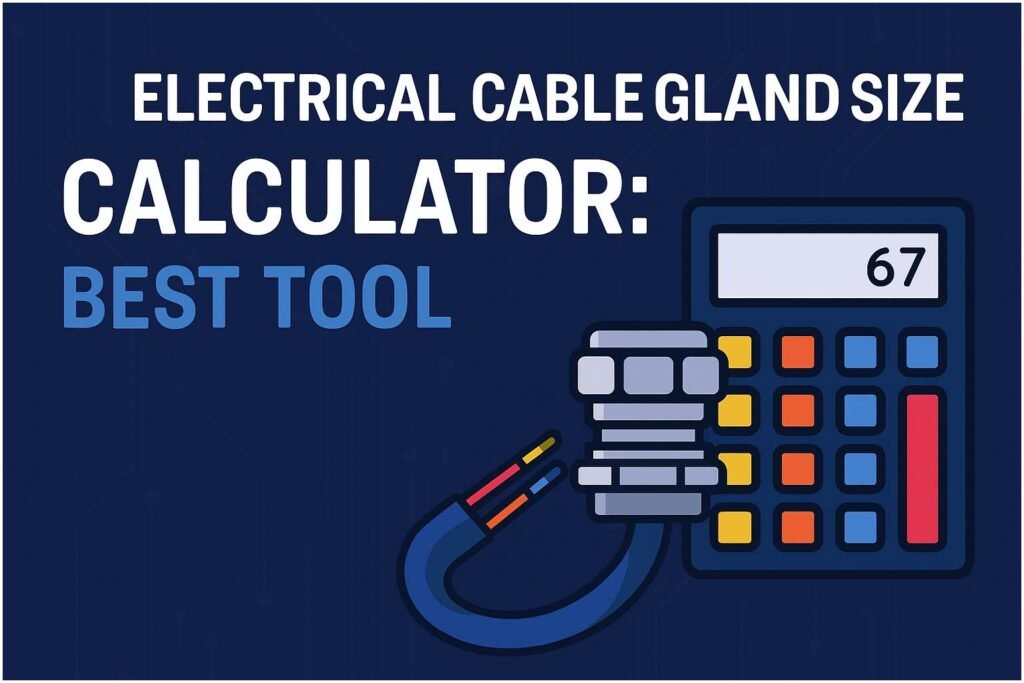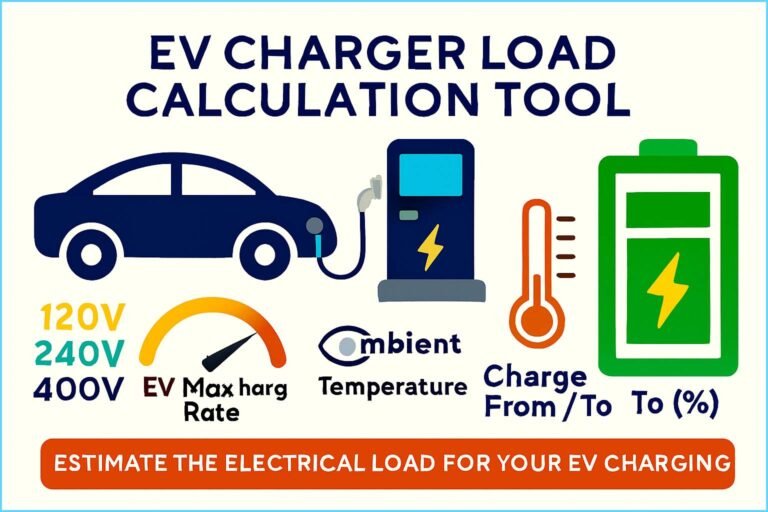Electrical Cable Gland Size Calculator: Best Tool
Choosing the right cable gland is one of the most important steps in any electrical installation. A gland that is too small can damage the cable sheath. A gland that is too large can fail to seal the cable properly. Both issues can create safety risks, moisture entry, and even system failure. That is why an electrical cable gland size calculator is so useful. It helps you choose the correct gland size based on the cable diameter, insulation type, and application.

Table of Contents
Many electricians and engineers rely on quick charts or online tools, but it is still important to understand how sizing works. This guide explains cable gland sizing in a simple and clear way. It also includes tables and examples to help you make the right choice every time. Use our online tool 3 phase cable size calculator
What Is an Electrical Cable Gland Size Calculator?
An electrical cable gland size calculator is a tool that matches a cable’s outer diameter with the correct gland size. It considers cable construction, entry threads, sealing requirements, and environmental conditions. You only need the cable’s outer diameter (OD) in millimeters. The calculator then suggests the right gland size, such as M20, M25, PG21, or NPT sizes.
These tools remove guesswork and save time. They also help ensure compliance with electrical standards. When the correct gland size is used, the cable stays secure, sealed, and protected against dust, water, and mechanical strain.
Electrical Cable Gland Size Calculator
Determine correct gland size based on cable diameter, type, and tolerance. Interactive and technically detailed.
| Gland Size | Min Dia (mm) | Max Dia (mm) |
|---|---|---|
| 20S | 6.0 | 12.0 |
| 20 | 10.0 | 14.0 |
| 25 | 14.0 | 20.0 |
| 32 | 20.0 | 26.0 |
| 40 | 26.0 | 32.0 |
| 50 | 32.0 | 40.0 |
| 63 | 40.0 | 50.0 |
| 75 | 50.0 | 60.0 |
– Select cable type (armoured, unarmoured, flexible).
– Enter overall cable diameter and inner sheath diameter in mm.
– Enter tolerance allowance (%) to account for manufacturing variation.
– Click “Calculate” to see recommended gland size range and PASS/FAIL check.
– Compare with reference table and manufacturer datasheet before final selection.
Formula check: Effective diameter = overall diameter × (1 + tolerance/100). Gland size is chosen such that min ≤ effective diameter ≤ max. Inner sheath diameter is used for armoured/flexible types to ensure grip range compliance.
Why Cable Gland Sizing Matters
Correct sizing is important for many reasons. A cable gland does more than hold a cable in place. It protects the connection point and ensures long-term reliability. Some key benefits of proper gland sizing include:
- Proper sealing against moisture and dust
- Protection against cable pull-out
- Compliance with IP ratings
- Reduced risk of cable damage
- Better fire protection in hazardous areas
If the gland size does not match the cable diameter, the seal will not close fully. This leaves gaps that can let in water and dust. Over time, this can lead to failure of the equipment. A correct size ensures a tight seal and safe operation. Try our free online tool today ev charger cable size calculator
How Cable Gland Size Is Measured
Cable gland sizes are usually based on thread type. The most common thread standards include:
- Metric (M sizes like M16, M20, M25)
- PG thread sizes (PG11, PG13.5, PG21)
- NPT thread sizes for industrial use
- BSP thread sizes, mostly in plumbing and industrial systems
Each size has a clamping range. For example, an M20 gland may fit cables from 6 mm to 12 mm OD. This range changes depending on the gland type and brand.
To use any electrical cable gland size calculator, you need one piece of information:
- Cable Outer Diameter (OD)
You can find this on the cable datasheet or by measuring it with a caliper.
Cable Gland Size Selection Table
The following table gives a general idea of which gland size matches each cable diameter. Actual values may vary by manufacturer, but this provides a reliable reference. Access our powerful online calculator now star delta motor cable size calculator
Common Metric Cable Gland Sizes
| Cable OD (mm) | Recommended Gland Size | Clamping Range (mm) |
|---|---|---|
| 3 – 6 mm | M12 | 3 – 6 mm |
| 4 – 8 mm | M16 | 4 – 8 mm |
| 6 – 12 mm | M20 | 6 – 12 mm |
| 9 – 14 mm | M25 | 9 – 14 mm |
| 13 – 18 mm | M32 | 13 – 18 mm |
| 18 – 25 mm | M40 | 18 – 25 mm |
| 22 – 32 mm | M50 | 22 – 32 mm |
| 30 – 38 mm | M63 | 30 – 38 mm |
These sizes are widely used in residential, commercial, and industrial wiring.
How an Electrical Cable Gland Size Calculator Works
Most calculators follow a simple formula. You enter the outer diameter of the cable. The tool checks its database of gland sizes and recommends a compatible size. Some advanced calculators also consider:
- Cable type (armored, unarmored)
- Cable insulation type
- IP rating requirements
- Temperature range
- Gland material
- Thread type
For armored cables (SWA cables), the calculator may ask for inner bedding diameter and armor type. This ensures a proper grip on the armor layers. Get instant results with our online tool earth cable size calculator
Factors That Affect Cable Gland Size Selection
Choosing the correct gland is not only about matching cable diameter. Here are other important factors.
Cable Type
Armored cables require glands with armor clamps. Unarmored cables use basic sealing glands. Flexible cables may need special clamping inserts.
Environment
Outdoor installations need IP67 or IP68 glands. Marine or chemical locations need stainless steel or brass glands.
Temperature
High-temperature areas may require silicon seals instead of standard rubber seals.
Thread Type Matching
The panel or enclosure hole must match the gland thread. A mismatch can cause leaks or insecure locking.
Material of the Gland
Glands are available in:
- Brass
- Stainless steel
- Plastic (nylon)
- Aluminum
Each material suits a different environment.
Step-By-Step Example Using a Cable Gland Size Calculator
Let’s take an example to understand how it works. Start using our easy-to-use online tool earthing cable size calculator
Example:
Cable: 4-core PVC insulated
Outer Diameter: 10.5 mm
Steps:
- Find the OD value (10.5 mm).
- Open the cable gland size calculator.
- Enter the OD value.
- The calculator suggests M20 gland.
This is because M20 glands usually support 6–12 mm clamping range.
Simple and accurate.
Table for Quick Cable OD Reference
Here is another useful table matching cable types with common OD values. This helps you check whether your measurement is within the typical range.
Typical Cable OD Values
| Cable Type | Cross Section | Approx OD (mm) |
|---|---|---|
| PVC Single Core | 2.5 mm² | 3 – 4 mm |
| PVC Twin & Earth | 2.5 mm² | 9 – 10 mm |
| PVC Multi-core | 4 core 4 mm² | 12 – 14 mm |
| Armored Cable (SWA) | 4 core 6 mm² | 17 – 19 mm |
| Flexible Rubber Cable | 10 mm² | 14 – 16 mm |
This table helps you verify the cable size quickly before selecting the gland. Calculate instantly with our smart online tool cable size calculator australia
Tips for Using an Electrical Cable Gland Size Calculator
Here are some practical tips to ensure accurate results:
- Always measure the cable OD with a precise tool.
- Check the manufacturer’s clamping range before final selection.
- Select the correct thread type based on the enclosure.
- For armored cables, use glands specifically designed for SWA.
- Avoid forcing a cable into a smaller gland to prevent sheath damage.
- Choose stainless steel glands for corrosive environments.
- Select higher IP ratings for outdoor or wet locations.
These simple steps ensure safe and long-lasting installations.
Common Mistakes to Avoid
Many installers make errors that can affect the cable performance. Here are a few common mistakes:
- Choosing a gland only by thread size and ignoring clamping range
- Using the wrong lug or termination with the gland
- Over-tightening the gland, which damages the insulation
- Ignoring environmental conditions like moisture or chemicals
Avoiding these mistakes saves time and prevents costly repairs. Experience fast and accurate results using our online tool cable size calculator uk
Final Thoughts
An electrical cable gland size calculator is a powerful and simple tool that ensures safe and efficient cable installations. It helps you match the cable outer diameter with the correct gland size, reducing risks and improving reliability. Understanding how gland sizing works gives you more confidence in selecting the right components for any electrical project. Explore our professional online tool for quick calculations kw to cable size calculator
Use the tables, follow the factors, and rely on accurate measurements. With the right gland size, your cable remains protected, sealed, and secure throughout its service life.
Make your task simple with our online tool electrical cable size calculator
Follow Us on Social:
Subscribe our Newsletter on Electrical Insights to get the latest updates in Electrical Engineering.
#ElectricalCableGland, #CableGlandCalculator, #ElectricalTools, #CableSizing, #GlandSizeCalculator, #ElectricalEngineering, #WireManagement, #IndustrialElectrical, #ElectricalSafety, #CableInstallation






